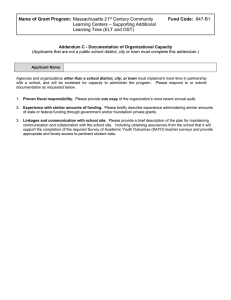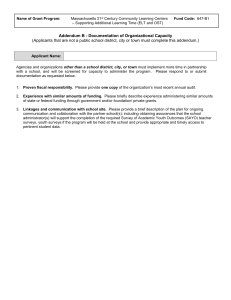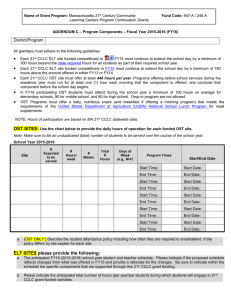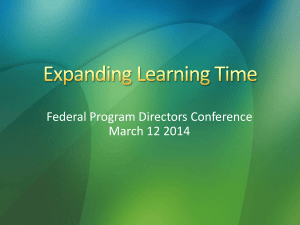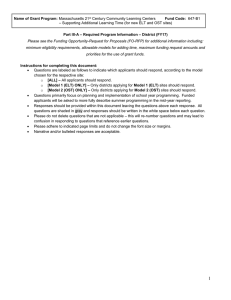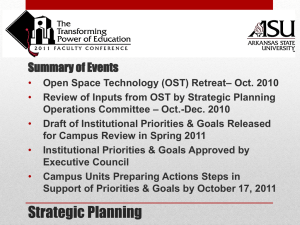1. Expanded Learning Time (ELT) 1. 225-C
advertisement
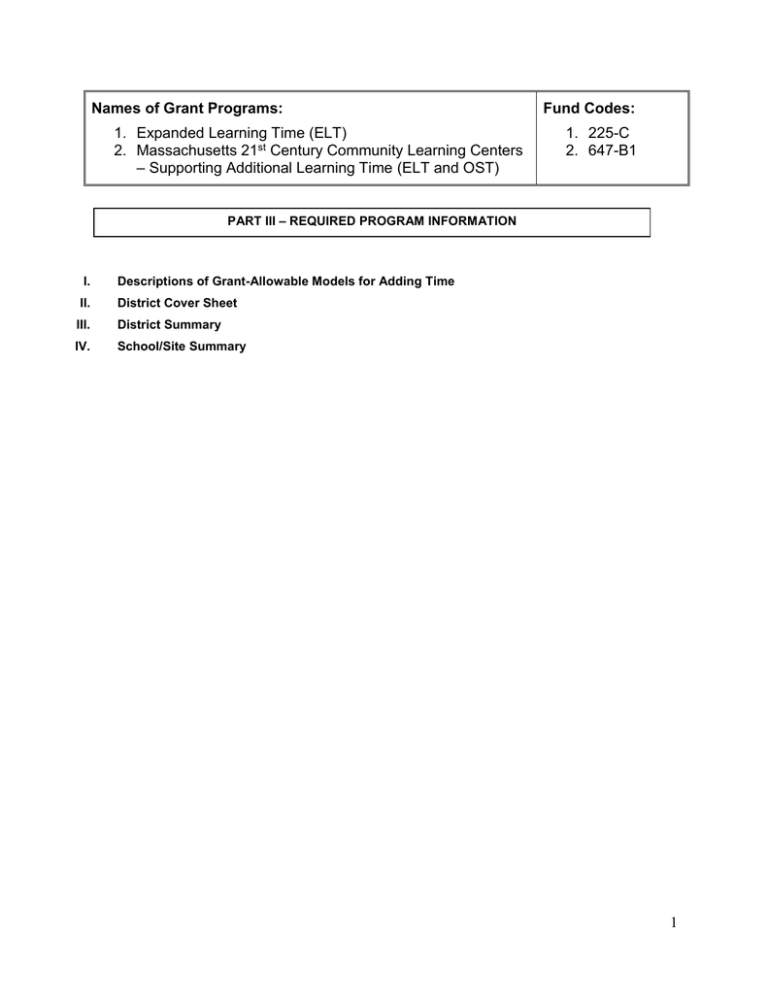
Names of Grant Programs: 1. Expanded Learning Time (ELT) 2. Massachusetts 21st Century Community Learning Centers – Supporting Additional Learning Time (ELT and OST) Fund Codes: 1. 225-C 2. 647-B1 PART III – REQUIRED PROGRAM INFORMATION I. Descriptions of Grant-Allowable Models for Adding Time II. District Cover Sheet III. District Summary IV. School/Site Summary 1 I. Descriptions of Grant-Allowable Models for Adding Time Please see the respective FO-RFP for additional details about each of these options, including maximum funding request amounts. If Choosing… May apply through… Fund Code 225-C (FC 225-C) Expanded Learning Time (ELT) Fund Code 647-B1 (FC 647-B1) Out-of-School Time Fund Code 647-B1 (OST) (FC 647-B1) Basic Description/Requirements For all students: Applicants will establish a school schedule, required for all students, that adds a substantial amount of additional hours to the school day, week and/or year so that they offer at least 300 hours above the state minimum requirements For all students: Applicants will establish a longer school day, week, and/or year that increases the total number of school hours required for all students by a minimum of 180 hours above the amount offered in either FY13 or FY14. For targeted students: Applicants choosing this option will offer a total of a minimum of 448 hours of OST programming during the school-year and summer for a targeted group of students. 2 II. DISTRICT COVER SHEET IMPORTANT NOTES: If applying for funding through both FC 225-C and FC 647-B1, please complete the district cover sheet (II) and district summary (III) once and include it with both applications. If the lead applicant is not a district (FC 647-B1 only), it should work with the district to complete the district cover sheet (II) and district summary (III) sections. Applicant (District/Agency): District/Agency Contact Name: Phone: Email: Fund Code and Model for Adding Time Proposed School(s)/Site(s) Include below all schools/sites proposed through either FC 225-C and FC 647-B1. FC 225-C: ELT FC 647-B1: Model 1 (ELT) FC 647-B1: Model 2 (OST) Total Request Competitive Priority: (Please put an ‘x’ in the box if applicable) Amount Requested* Please place an ‘x’ in the appropriate box for each school/site proposed. School Year Summer Total $ $ $ $ $ $ $ $ $ $ $ $ $ $ $ [For FC 647-B1 Model 2 (OST) Applicants Only] Districts that have not received 21st CCLC funding within at least the past three years (FY12-FY14). Additional Time Offered at Other District Schools/Sites (Please list any schools/sites in the district that currently offer ELT or OST, regardless of whether funded through FC 647 or FC 225. Add rows as needed.) Total Additional Hours Offered Annually Model for Additional Time ELT OST (for all students) (for targeted students) *Please see the FO-RFP documents for maximum funding request amounts. 3 III. DISTRICT SUMMARY Instructions: Please address each of the following questions within the indicated page limits. Responses should be provided within this document, without changing the format or font size, and leaving the questions above each response. A. District Process and Rationale for Adding Time (3 pages maximum): 1. Identify the elements of the district’s existing improvement, turnaround and/or other strategic plans that will be addressed through the proposed additional time. 2. Describe the reasons for proposing the school(s)/site(s) included in this application (as opposed to another/others in the district, if there is more than one school in the district). 3. Describe lessons learned from past experiences running ELT and/or OST programs, how those lessons have been applied to this application, and what will be different about this program compared to the previous one(s). a. [FC 647-B1 Model 2 (OST) ONLY, If the proposed school/site received 21st CCLC OST funding during any of the following years: FY10-FY13]). Please indicate whether after-school program(s) continued to operate at the proposed school(s)/site(s), even if at a reduced level. (REMINDER: Any school/site that received funding during FY14 is not eligible to apply for a FY15 FC 647-B1 grant.) If yes, describe the current program. If no, explain why not. B. District Support and Sustainability (3 pages maximum): Describe preliminary plans for supporting and sustaining additional time. Your response must include: 1. A description of the ways in which the district/lead applicant will collaborate with the school(s)/site(s) to support implementation of additional time, including in making budgetary decisions. 2. [FC 225-C and FC 647-B1 Model 1 (ELT) ONLY] A description of plans for negotiating collective bargaining agreements to maximize financial support for additional time, if applicable. 3. [FC 225-C and FC 647-B1 Model 1 (ELT) ONLY] A description of how current organizational priorities may be streamlined to allow for the reallocation of resources and support structures for additional time, if applicable. 4. A description of the ways in which partners with shared priorities will support the success and affordability of additional time. 4 5. A description outlining plans to seek and secure additional funding from sources other than this grant, to support both implementation and sustainability of the added time, including: a. how the district/applicant will coordinate this grant with other federal, state and local programs with compatible/complementary services (e.g., Academic Support, McKinney-Vento, Title I, Title III, Adult Basic Education, Gateway Cities, Wrap Around Zones, Mass Grad, etc.); and b. any planned/anticipated support (financial and other) from municipalities, counties, school districts, and/or private/community foundations. c. Also complete the chart below with anticipated costs associated with adding time at the proposed school(s)/site(s), as well as possible funding sources that will be used to support these costs. Funding Category Anticipated FY15 Costs (associated with adding time) Possible source(s) for supporting these costs (federal, state, local, private, etc.) Staffing (including, but not limited to, instructional staff, planning time, substitutes, etc.) Professional Development Partners/Vendors Materials/Supplies Transportation Other: (please describe below) TOTAL ANTICIPATED FY15 COSTS Note: Level 2-5 districts are permitted to use their Title I, Part A reservation funds [formerly supplemental educational services (SES) and public school choice set-aside funding] to support district/student needs as assessed in relation to the Conditions for School Effectiveness. This means that a district can choose to direct part or all of its Title I, Part A allocation (which could also include Title II, Part A funds flexed into Title I, Part A) to support additional time in one or more schools, if the district determines that will best meet the needs of the district's lowest performing students. 5 IV. SCHOOL/SITE SUMMARY IMPORTANT NOTES: Applicants should submit a separate School/Site Summary (IV, pages 6-14) for each school/site included in the proposal. Applicants may request funds for only one model for adding time per school/site proposed, and: o Up to two school(s) through FC 647-B1, Model 1 (ELT); and o A maximum of one school/site through FC 647-B1, Model 2 (OST). The same school(s)/site(s) may not be proposed under both FC 225-C and FC 647-B1. School/Site Name: School/Site Contact Name: Phone: Competitive Priority: (Place an ‘x’ in the box for each that apply.) Email: [FC 225-C ONLY] Highest competitive priority will be given to proposals requesting a maximum of $800.00 per pupil from this grant. Grant funds will be used to support implementation of at least 300 hours of additional time, and where necessary, applicants must include a proposal to support other anticipated costs associated with implementing ELT that will not be covered using grant funds. Proposing to implement more time in a school designated as Level 3, 4, or 5 under Massachusetts' district and school accountability and assistance system Please indicate Proposing to serve youth in schools/communities with the % below: higher percentages of families with low income, as indicated at the Department's School and District profiles page (http://profiles.doe.mass.edu/). Proposing targeted strategies to support reading proficiency by grade 3 and/or successful transition into grade 9. Note: Proposed grant activities that will support this priority should be clearly outlined in the responses to Section D below. Submitting this application in full partnership that includes a school district, and a community-based organization(s) or other public or private entity(ies). The following competitive priorities apply to ELT Applicants Only [FC 225-C and FC 647-B1 Model 1 (ELT)] Proposing a year-round school model or at least a substantial amount of time for all students during the summer. Proposing the use of blended learning strategies. Proposing to add time at a middle school. Instructions: Please address each of the following questions within the indicated word/page limits. Responses should be provided within this document, without changing the format or font size, and leaving the questions above each response. A. Process and Rationale for Additional Time: (3 pages maximum) a. Identify the school’s/site’s specific needs and priorities related to student learning (including academic, social-emotional, wellness, etc.) that will be addressed through the proposed additional time.* *Note: The school’s needs/priorities should be identified from existing school improvement, turnaround, or other plans guiding current work. Schools should use the Conditions for School Effectiveness as benchmarks against which to gauge practice in key areas. 6 b. Identify the school’s/site’s structures and processes for planning for, implementing and monitoring additional time to better meet student needs. Include a description of the planning team that developed this proposal, and their respective roles. Describe how stakeholders were and will be involved in planning and implementing additional time. [FC 647-B1 Applicants ONLY] Complete Addendum B describing the required advisory community council/group. c. Describe the reasons for choosing to implement additional time using the selected model (ELT or OST.) Include how data was used to support decisions related to the selected model as well as the programming/activities to be implemented. B. Accountability and Evaluation (1 page maximum): Describe previous experience with program evaluation. NOTE: All FC 647-B1 grantees are required to use the Survey of Academic Youth Outcomes (SAYO) evaluation instrument developed by the Department and the National Institute on Out-of-School-Time (NIOST). Upon approval, grantees will be required to customize and select specific SAYO outcomes, and will be provided with the tool and training on its implementation. For more information on the SAYO tool, see: http://www.doe.mass.edu/21cclc/ta/sayo.html. C. [FC 647-B1 ONLY] Proposed Typical Day (1 page maximum): Provide a narrative summarizing what a typical day that includes additional time will look like at the proposed school/site. This summary should highlight proposed creative and innovative practices and give grant reviewers an idea of how students will experience their newly expanded day as a result of this grant. The specifics of implementation are provided in the next question. D. Implementing Additional Time (10 pages maximum, including charts): a. [FC 647-B1 Model 2 (OST) ONLY] Describe the specific targeted population to be served through grantfunded programming/activities. i. Describe planned outreach strategies to recruit and retain the students targeted for participation in the proposed OST program. b. [ALL APPLICANTS] Using the four charts on the following pages, describe the proposed activities (made possible with additional time, and in particular by this grant) that align with school priorities and the targeted needs related to:* 1. engaging instructional practices, 2. professional development and teacher collaboration, 3. enrichment opportunities, and 4. school-community partnerships. *See the Planning Resources in the FO-RFP under Grant Requirements for more information about encouraged grant activities and areas to consider in program design. 7 1. Engaging Instructional Practices: One priority of this grant is to use additional time to develop creative and innovative opportunities to accelerate student learning and deepen engagement. Applicants should include how the school/site will incorporate service-learning, inquirybased learning and/or project-based learning as an instructional strategy. The Department will provide training to support this required component of the grant. Proposed Activities to be Implemented Using Additional Time: Describe the additional or enhanced opportunities for engaging instruction that will be provided as a result of adding time, and in particular as a result of this grant. Needs/Priorities Addressed: Describe how the proposed activities support school/district priorities, meet an identified need and/or gap in services, and/or expand current program offerings. Note: The need may include insufficient time to fully implement current promising practices in this area. If so, please describe those practices. Budget Justification: Describe how requested grant funds will support the proposed activities described in this area. 8 2. Professional Development (PD) and Teacher Collaboration: One priority of this grant is to maximize additional time in order to embed opportunities for teachers, staff and providers to collaborate and to continuously improve practices. Proposed Activities to be Implemented Using Additional Time: Describe the opportunities for and structure of professional development and teacher collaboration that will be provided or enhanced by adding time, and in particular as a result of this grant. Note: Describe plans to include contracted providers/partners/volunteers that will be working directly with students in PD and collaborative efforts. Needs/Priorities Addressed: Describe how the proposed activities support school/district priorities, meet an identified need and/or gap in services, and/or expand current program practices. Note: The need may include insufficient time to fully implement current promising practices in this area. If so, please describe those practices. Budget Justification: Describe how requested grant funds will support the proposed activities described in this area. Note: [FC 647-B1 ONLY] Applicants should include funds to support the program coordinator’s attendance at a two-day 21st CCLC Summer Institute typically held in July, sponsored by the US Department of Education. Conference participants are responsible for airfare, hotel and other travel-related expenses. 9 3. Engaging Enrichment Opportunities: One priority of this grant is to provide additional creative, innovative and engaging enrichment opportunities for students beyond traditional academics; as well as opportunities that support social-emotional learning, wellness, civic engagement, etc. Enrichment opportunities should be thoughtfully planned to integrate academics and other skills for college and career readiness. Proposed Activities to be Implemented Using Additional Time: Describe the additional opportunities for engaging enrichment that will be provided by adding time, and in particular as a result of this grant. Include any specific grant-funded activities that will support the social/emotional needs of the students served. Needs/Priorities Addressed: Describe how the proposed activities support school/district priorities, meet an identified need and/or gap in services, and/or expand current program offerings. Note: The need may include insufficient time to fully implement current promising practices in this area. If so, please describe those practices. Budget Justification: Describe how requested grant funds will support the proposed activities described in this area. 10 4. School-Community Partnerships: One priority of this grant is to support and strengthen partnerships among schools/sites, families and communities that advance common goals for student success. Proposed Activities to be Implemented Using Additional Time: Describe the additional opportunities for building and strengthening partnerships that will occur as a result of adding time and in particular of this grant. If the program plans to contract with any outside vendors/community based agencies, describe the criteria used for selecting contracted providers and how the services they will provide connect to and support identified needs and intended outcomes. Use Addendum F to include a budget and budget narrative for each contracted provider. Needs/Priorities Addressed: Describe how the proposed activities support school/district priorities, meet an identified need and/or gap in services and/or expand current program offerings. Note: The need may include insufficient time to fully implement current promising practices in this area. If so, please describe those practices Budget Justification: Describe how requested grant funds will support the proposed activities described in this area. [FC 647-B1 ONLY] Note: In this section, please be sure to include the proposed family engagement activities, as well as a description of the specific related family engagement expenditures (which must total a minimum of 5% of the grant request). 11 E. Schedule [FC 225-C and FC 647-B1 Model 1 (ELT) ONLY] (5 pages maximum): a. Use the chart below to provide information about school hours (required for all students) currently in FY14 (2013-2014), and projected for FY15 (2014-2015): SAMPLE YEAR Date school began: Start/End Time 8:15 – 2:15 8:15 – 12:15 (early release days) FY14 (2013-2014)* Date school ends: 9/2/2014 Hours 6 4 TOTALS Date school began: Current Enrollment # of days 170 10 180 6/19/2015 Total Hours 1020 40 1080 Date school ends: Current Grades Served: School Start/End Time [insert rows if needed] Hours # of days Total Hours TOTALS PROJECTED FOR FY15 (2014-2015) Date school begins: Anticipated Enrollment: Date school ends: Anticipated Grades Served: School Start/End Time [insert rows if needed] Hours # of days Total Hours TOTALS b. [FC 225-C and FC 647-B1 Model 1 (ELT) ONLY] Provide the following schedules: (please insert schedules into this document) i. Current Student Schedule (FY14)* ii. Current Teacher Schedule (FY14)* iii. Proposed Student Schedule (FY15) iv. Proposed Teacher Schedule (FY15) * FC 647-B1 Model 1 (ELT) ONLY Also provide this information for FY13 (2012-2013), if time was added in FY14. 12 [FC 647-B1 Model 2 (OST) ONLY] (2 pages maximum) a. Use the charts below to provide information about the proposed OST program schedule. NOTE: Please see below for important guidelines/requirements for OST program operation. Anticipated # Youth to be Served # Hours / week # Weeks Total # Hours Days of Week (e.g., M-F) Program Times Start Time: School Year (before school) End Time: Start Time: School Year (after school) End Time: Start Time: Summer End Time: Total # of Hours Offered: b. Describe the student attendance policy for the proposed 21st CCLC OST and summer program. Include for both how often students are required to attend. c. Describe the location and space in which the OST program will take place. Describe how the space and environment will be welcoming, have the necessary resources to fully implement program activities, stimulate learning, and provide space to exhibit students' work and projects. Please refer to the Grant Assurances document regarding space requirements. d. Describe how the program will meet the United States Department of Agriculture (USDA) National School Lunch Program requirements for meal supplements, in offering a daily nutritious snack and breakfast (if offering a morning/before-school program). e. Summer Program Description: Provide a brief description of plans for implementing the required summer program. All FC 647-B1 grantees proposing OST must adhere to the following guidelines: Hours of Operation Options: In general, programs must offer a minimum of 8 hours per week during the school year. The following are recommended options for program hours; however programs may also propose something different, so long as the required minimum number of hours are offered. School Year Minimum Summer Minimum 384 Hours (12 hrs./wk. x 32 wks) 64 Hours [16 hrs./wk. (4 hrs./day for 4 days/wk.) x 4 wks.] Includes before school 256 Hours (8 hrs./wk. x 32 wks.) 192 Hours [24 hrs./wk. (6 hrs./day x 4 days) x 8 wks.] Funds cannot be used to support only before school and/or summer programs. If proposed, before-school services must run for at least one (1) hour each morning offered, and conclude before the school day begins. Students must attend the offered school year programming for, on average, a minimum of 100 hours (elementary), 90 (middle) and 80 (high).* Drop-in programs are not allowed. *Required average hours are based on MA 21st CCLC statewide data. Vacation week programs may not be counted towards total hours unless serving the same students that attend the OST program. 13 F. Transportation (1 page maximum): [FC 647-B1 Model 2 (OST) ONLY – for both school-based and/or off-site programs] As required by federal legislation describe how will you ensure that students travel safely to and from the OST program and home. G. Staffing (2 pages maximum): a. [FC 225-C and FC 647-B1 Model 1 (ELT) ONLY] i. Briefly describe how ELT will impact staffing levels and schedules and what flexibilities the school has in this area to enable effective and cost-effective implementation of ELT. ii. Please provide a description of any necessary changes that were/will be made in collective bargaining agreements, school charters, or in other areas that affect the proposed ELT. Where applicable, schools must include documentation of changes to collective bargaining agreements, charters, etc. iii. If applicable, describe how qualified volunteers will be used to support proposed activities. b. [FC 647-B1 Model 2 (OST) ONLY] All staff must meet the qualifications listed in the Grant Assurances document. i. Describe the qualifications/staff credentials the program will be seeking for the required positions below: Program/Site Coordinator (If the program coordinator position has been designated describe their qualifications) Program staff ii. Describe how staff has the required qualifications, training and support to meet the needs of the targeted population including students on IEPs, and English Language Learners. iii. Include the anticipated student-to-staff ratios, and plans for quality personnel recruitment and retention. iv. Describe plans to provide CPR and first aid (at least within two months of employment) to program staff. v. If applicable, describe how qualified volunteers will be used to support proposed activities 14
